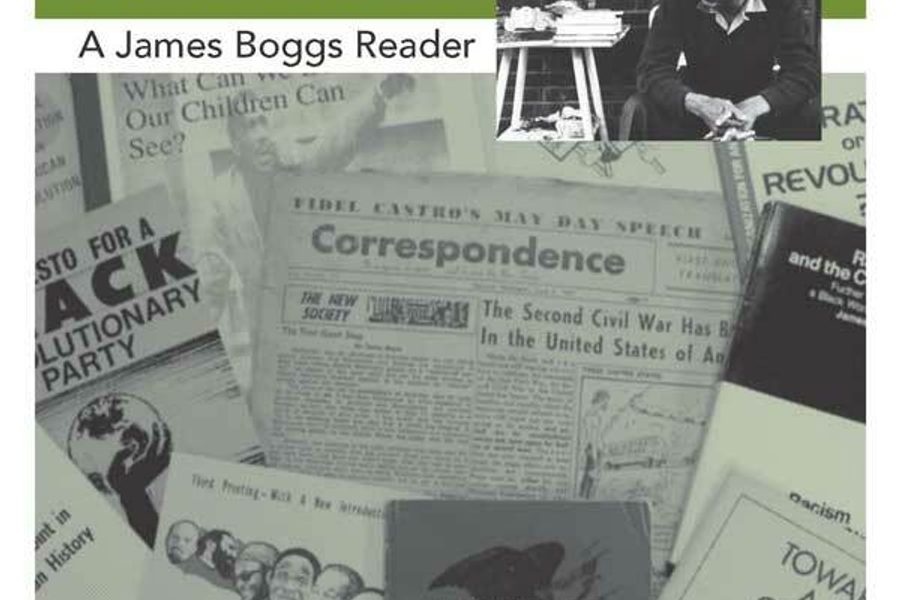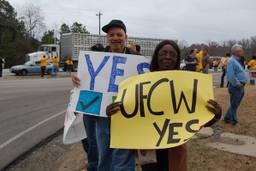A Black Radical’s Notebook
A new book makes Detroit ‘revolutionist’ James Boggs’ long career accessible to current activists remaking the Motor City.
Paul Abowd

Pages from a Black Radical’s Notebook: A James Boggs Reader is the first volume to compile the writings of tireless Detroit revolutionist James Boggs. The book’s contents comprise half a century of Boggs’ writing and document his evolution as a rank-and-file autoworker, a leader in the civil rights and black power movements, and a visionary thinker about how Detroit’s post-industrial crisis might spark revolution.
Boggs, author of the 1963 book The American Revolution: Pages from a Negro Worker’s Notebook, was married to his collaborator – feminist, activist and author Grace Lee Boggs–for 40 years before his death in 1993. As the matriarch of Detroit’s activist community, she continues their work today at age 95.
In February, I discussed James Boggs’ legacy with University of Michigan Professor Stephen Ward, who edited the compilation.
What were Jimmy Boggs’ early experiences in Detroit?
Jimmy came to Detroit in the summer of 1937 during the Depression, looking for work in the auto industry. He couldn’t find a job, but he came back in 1940 and started at the Chrysler Jefferson plant. He became involved in United Auto Workers (UAW) and radical politics, as well as civil rights politics – which were all intertwined for him.
By the early ’50s he became part of a radical group when Grace Lee and C.L.R. James came to Detroit. Later, Jimmy and Grace left the Trotskyist movement and became an independent Marxist organization. They started a newspaper called Correspondence, which they took from the Committees of Correspondence during the American Revolution. They saw it as an expression of the ideas, sentiments and aspirations of the working class. They saw African Americans and women as an important part of a new American revolution. They were driven by the belief that rank-and-file workers, not the labor movement, could create their own movement and lead their own revolution.
If you’ll permit a slight digression, the spontaneity that we’ve seen in the Egyptian revolution is something that C.L.R. and others in the group were talking about. In ‘57, C.L.R. was excited about the Hungarian revolution. Jimmy had a different take. Based on his experience in labor movement, he’d seen it go from radical possibilities in the ’40s to what he called an interest group by the mid-50s, after the AFL and CIO had merged. By ‘57, Jimmy has seen the labor movement change in the post-war society. He got excited when the workers did anything to revolt, but for him, what was happening in Hungary was not as exciting as what was happening in the third world. Nineteen fifty-seven was also the year of the Ghanaian revolution – the first African nation to gain independence. This was an early expression of their diverging political focus.
Can you say more about how Jimmy’s focus evolved in the post-war period?
During the late ’40s Jimmy was part of the Discrimination Action Committee, which was led by Detroit’s NAACP but with heavy involvement by black workers. They were fighting discrimination in restaurants and in the plants, and it spread to bowling alleys and other spaces. Jimmy was part of radical politics, and he was part of the Fair Practices Committee in his local, but he was beginning to see the labor movement’s limitations.
One of the themes running through the book, and through Jimmy’s work, is that that revolutionary ideas can become reactionary. The need for constant evolution and re-evaluation is vital.
That’s right. Grace calls it the importance of dialectical thinking. In the early ’40s, Jimmy’s politics were rooted in labor movement, but a decade later he’s part of labor but looking for revolutionary possibilities elsewhere. In the ’60s he’s starting to see automation – the changes in production process and factory life. Jimmy saw an increasing use of advanced technology in plants undercutting the need for mass employment, which had been the basis of union movement in ’30s. Labor was unable to respond to this change. Labor’s fight was for a rightful place in the American economy, but that couldn’t be realized because of changes in production.
By the early ’60s, Jimmy began to see the African-American struggle for democratic rights as having the potential to forge revolutionary change. In his ‘63 book The American Revolution, he argues that Black struggle is replacing working-class struggle as a potential revolutionary force. He was rejecting a particular strand of Marxism.
How did Jimmy interact with black worker movements that appeared to form an intersection of black power and rank-and-file organizing?
People from the Dodge Revolutionary Union Movement had formed a UHURU [a black radical student group] at Wayne State university in ‘63. Jimmy had been in the plant for 20 years by then, and was something of a mentor to General Baker and others. By ‘68 Baker and others had formed DRUM and in ‘69 the League of Revolutionary Black Workers was becoming stronger in the plants.
At the same time, overall employment was declining and you have white workers leaving the city and the plants. The experience in the plants was different than Jimmy’s was. There was a divergence in their personal and political experiences, their historical understandings, and their political projects – but they all remained part of the black power movement in Detroit and nationally.
What was the next moment of evolution for Jimmy and Grace during the “post-industrial” era?
The black power movement was dissipating by the mid-’70s when Jimmy and Grace formed the National Organization for American Revolution. It was a cadre organization trying to develop committed revolutionaries. But for the first time in their careers they were trying to create a revolution without a substantial social movement taking place. They were in the post-industrial crisis and had had a decade of black leadership in Detroit with Coleman Young. This is also the decade of crack, and AIDS for that matter. By the late ’80s there’s a really extreme experience with youth violence and gun violence in the city. Of course, de-industrialization is a major element of this context.
Jimmy and Grace began to focus on local, community-based efforts. They created a range of organizations: We the People Reclaim Our Streets (WEPROS); they worked with a group called Save Our Sons and Daughters (SOSAD), founded by Clementine Barfield and mothers whose children had been victims of youth violence. A lot of pieces from the SOSAD newsletter form the last section of the Boggs Reader. … Jimmy was actively involved in this type of work until his death in ‘93.
How did Jimmy and Grace approach the reality of growing material inequality and austerity in the ’70s and ’80s in relation to their growing focus on revolutionary work through community building?
Grace and Jimmy have said their experiences in struggle in the ’40s and ’50s and ’60s taught them that the struggle to create revolutionary change cannot just be for things – for material conditions. People and communities have to be transformed. Jimmy and Grace were central in the efforts at creating black power in the city in the ’60s. But that experience confirmed for them that just achieving political power was not enough. It was important and necessary, but not enough.
Their ‘74 book Revolution and Evolution in the Twentieth Century says that Americans will have to make the first revolution in history that’s not for material goods. We’d have to give up some things. The revolutionary struggle couldn’t be just about bread, for more things, but for new human relationships and new ways for societies to be organized to build healthy and vibrant communities.
In ‘92, just before he passed, Jimmy wrote something like “my ideology is constantly changing, with one constant: it has to advance humanity.” That’s a summary statement about his thinking on revolution.
What is also important to understand in Jimmy and Grace’s long activist career is his distinction between a revolutionary and a revolutionist. A revolutionary may have some ideas about how society should be changed and run. But a revolutionist makes a commitment to put those ideas into being. It helps us understand how they moved through decades of different movements with a commitment to revolutionary change and a commitment to continuing struggle.
Pages from a Black Radical’s Notebook is available for purchase here.








